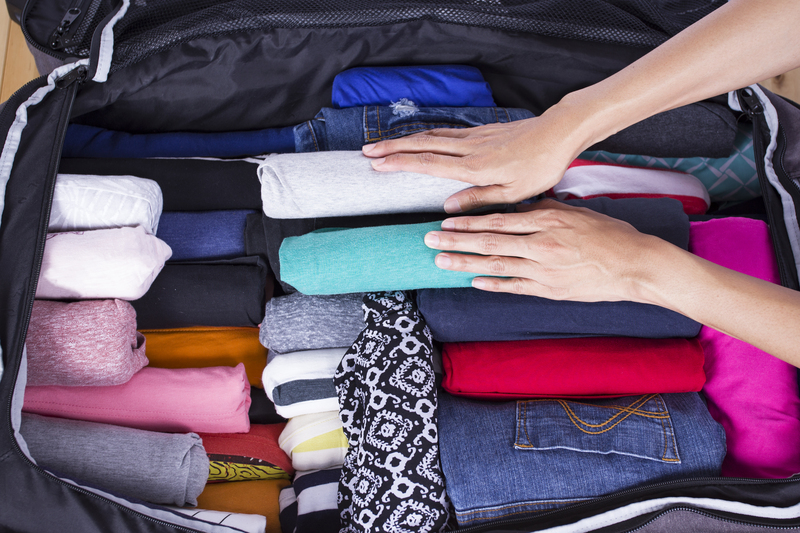From Chaos to Order: How to Pack for Moving House
Posted on 07/06/2025
From Chaos to Order: How to Pack for Moving House
Moving house can feel overwhelming, but mastering the art of packing is the key to a smooth transition. With strategic planning, careful organization, and the right techniques, you can transform a potentially chaotic experience into one of efficiency and even enjoyment. In this comprehensive guide, we'll walk you step-by-step through how to pack for moving house--from decluttering strategies to packing hacks and what to do on moving day. Whether this is your first move or your tenth, these expert moving tips will help you achieve order amidst the chaos.
Why Packing for a Move Can Be Challenging
Packing to move is more than just putting items in boxes. It's an opportunity to declutter, organize, and safeguard your possessions for transport. However, it is also one of the most demanding aspects of moving, due to:
- Time constraints: Juggling work, family, and packing duties can be stressful.
- Emotional attachment: Letting go of belongings can be tough.
- Logistical hurdles: Proper packing materials and organization are essential.
- Risk of damage: Without the right techniques, items are prone to breakage.
By packing for moving house in an organized manner, you can streamline the process and make unpacking in your new home far easier.

Step 1: Create a Moving Plan
Before you start packing, develop a detailed moving checklist to keep track of your tasks. Your plan should include:
- Setting a moving date and booking a moving company or rental van.
- Creating a timeline with deadlines for each stage of packing.
- Inventorying your household items to determine what to keep, donate, or discard.
- Gathering packing supplies such as boxes, bubble wrap, packing paper, tape, and markers.
Establishing a clear plan brings focus and direction to the moving process.
Helpful Tip:
Use digital tools like Trello or Excel to create interactive checklists and track your progress.
Step 2: Declutter Room by Room
One of the greatest benefits of moving is the opportunity to declutter. Systematically go through each room and categorize your belongings:
- Keep: Items you use regularly and want in your new home.
- Donate: Gently used items others can benefit from.
- Sell: Items in good condition that could fetch extra cash.
- Recycle or Dispose: Broken, outdated, or unusable items.
Ask yourself: Have I used this in the last year? If not, it's probably time to let it go.
Benefits of Decluttering Before Packing for a Big Move
- Less to pack: Reduces stress and saves time.
- Lower moving costs: Moving companies often charge by weight or volume.
- A fresh start: Arrive at your new home with only the essentials.
Step 3: Gather and Label Packing Supplies
Efficient packing for moving house starts with the right supplies. Stock up on:
- Sturdy cardboard boxes in various sizes
- Plastic bins for fragile or valuable items
- Bubble wrap and packing paper for delicate pieces
- Packing tape and strong markers for labeling
- Ziplock bags for screws, cables, and small parts
- Stretch wrap for furniture and appliances
Label Everything
Clearly label each box with its contents and the room it belongs to in your new home. Use a color-coding system or printed labels for even greater organization.
Step 4: Pack Non-Essentials First
Start by packing items you use the least, such as:
- Out-of-season clothing and shoes
- Books, DVDs, and decor
- Extra linens and bedding
- Rarely used kitchenware and appliances
This method allows you to remain comfortable while still making significant progress on your packing list.
Step 5: A Room-by-Room Packing Approach
Tackle one room at a time to maintain order and minimize confusion. Here are tips for the most common areas of the house:
How to Pack the Kitchen for Moving House
- Start with items you use infrequently--cake stands, serving trays, and specialty gadgets.
- Wrap glassware and dishes in bubble wrap or packing paper, placing heavy items at the bottom of boxes.
- Seal open containers and pack all perishable food separately, or dispose of it before moving day.
- Bundle knives securely with cardboard and tape.
Pro Tip: Label boxes containing fragile items as "FRAGILE" and keep them near the top of the moving truck.
Packing Bedrooms and Wardrobes
- Use wardrobe boxes to hang clothes and prevent wrinkles.
- Pack off-season clothes first; leave easy access to sleep essentials for your last night.
- Keep valuables and important documents with you, not in the moving truck.
Packing the Living Room
- Disassemble furniture if possible and keep screws/bits in clearly labeled bags.
- Use blankets to wrap mirrors and delicate electronics.
- Label remote controls and cables to make reassembly easier.
Packing Bathrooms
- Pack toiletries in ziplock bags to avoid leaks.
- Dispose of nearly-empty products or combine them to save space.
- Keep daily essentials accessible in a clear, labeled bag.
Step 6: Pack Smart - Top Tips for an Organized Move
Packing for a move is as much about strategy as it is about effort. Here are some established moving and packing tips:
- Heavy items in small boxes, light items in large boxes: Prevents injuries and box breakage.
- Don't leave empty space: Fill gaps with towels, socks, or soft items to avoid shifting.
- Tape boxes securely: Reinforce the bottom and seams.
- Keep essentials separate: Prepare a "first night" box with toiletries, medications, chargers, and basic kitchenware.
- Photograph electronics before unplugging: Reference these for easier setup later.
- Use suitcases for heavy items: They're designed to carry weight and have wheels for easy transport.
Using Professional Packing Services
If time is tight or you have valuable items, consider hiring professional packers. Many moving companies offer customized packing solutions that guarantee safe and efficient transport of even the most delicate belongings.
Step 7: Special Handling for Fragile and Valuable Items
When packing fragile or valuable possessions for a move, extra caution is essential. Here's how to keep them safe:
- Double-wrap china, glassware, and ornaments with bubble wrap.
- Use dish barrels or reinforced boxes for optimal protection.
- Pack framed artwork upright, padding the corners.
- Wrap electronics in anti-static bubble wrap and insert cables into labeled Ziploc bags.
Never overload boxes containing fragile items. Label all sides as "Fragile" and indicate which way is up.
Step 8: Don't Forget Outdoor and Garage Items
The backyard, shed, and garage often get overlooked. When packing for a move, don't forget to:
- Drain fuel from power tools and lawnmowers.
- Bundle garden tools neatly and wrap sharp edges.
- Dispose safely of hazardous substances (paint, pesticides, etc.).
- Pack bikes, grills, and outdoor furniture securely to prevent damage.
Step 9: Last-Minute Packing Advice
As moving day approaches, the chaos may rise. Here are strategies for staying organized:
- Start early: Allow more time than you think you'll need for each room.
- Color-code boxes: Assign each room a color and mark boxes accordingly.
- Keep important documents on hand: Don't pack passports, rental agreements, or medical records.
- Stay flexible: Moving plans can change, so be ready to adapt.
What Should Go Into Your Essentials Box?
- Toiletries and cleaning supplies
- Medications and first aid kit
- Snacks and bottled water
- Phone charger and basic utensils
- Pet food (if applicable)
- Important documents and valuables
Keep this box with you in your car or easily accessible in the moving van.
Step 10: Moving Day and Beyond
With everything packed and labeled, moving day will be far less chaotic. On the big day:
- Communicate with movers: Direct them regarding fragile or high-priority boxes.
- Double-check cupboards and closets: Avoid leaving anything behind.
- Keep pathways clear: Make sure nothing obstructs exits for a smooth load-out.
- Check off items on your inventory list: Ensure nothing is missing during loading and unloading.
Unpacking and Settling In
Congratulations! You've gone from chaos to order by packing smart for moving house. As you unpack, follow these tips:
- Start with essentials: Set up bedrooms, bathrooms, and the kitchen first.
- Take your time: Don't rush to unpack everything at once.
- Recycle packing materials: Most can be reused or given away to others who are moving.
- Update your address: Inform banks, employers, and utility providers of your new details.
Bonus Tips: Packing for a Move With Kids or Pets
Moving with children or animals adds a layer of complexity. To ease their transition:
- Involve children in packing their favorite toys; let them design their own "essentials box."
- Hire a sitter or arrange for pets to stay with family on moving day.
- Keep familiar bedding and toys accessible to help them adjust in the new home.
Maintaining routines and keeping favorite items close can help everyone adjust faster.

Frequently Asked Questions About Packing for Moving House
How far in advance should I start packing for a move?
Ideally, start packing non-essentials 4-6 weeks before your move date. Save daily use items for the final week.
What items should not be packed in a moving truck?
- Perishable food
- Important documents
- Medications
- Valuables (jewelry, cash, collectibles)
- Hazardous materials
What can I do to reduce stress while packing for a house move?
Stay organized with lists, take frequent breaks, enlist help from friends or professionals, and don't be afraid to ask neighbors for boxes or packing supplies.
Conclusion: Packing for Moving House Doesn't Have to Be Chaotic
By following a room-by-room, systematic approach and packing smartly for moving house, you'll minimize stress and maximize efficiency. With this detailed guide, you can turn the chaos of moving into a manageable--and even rewarding--process. Remember, the secret to a seamless move is to stay organized, start early, and keep only what you truly need. Here's to a happy, orderly new beginning in your new home!
```


 Guide price for the hire of a Transit Van /up to 300 cu ft/.
Guide price for the hire of a Transit Van /up to 300 cu ft/.